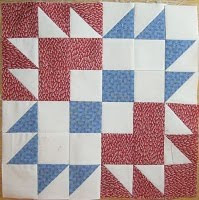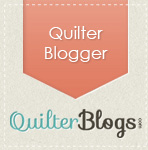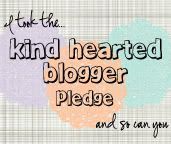1. Start off with a square of fabric, (you will trim this down later). I used a 2 1/2" square, you can guesstimate the size - it doesn't have to be perfect.. I am using a one inch hexagon paper piece.

You will start off at two corners of the fabric and the paper piece.
I am using black thread so you can see this better. I am also using hand quilting thread (1 strand) as it is stronger than regular thread.
I like this method because it's quicker to get my pieces ready to be stitched together and you don't have to remove any of the basting thread like you have to if you use the other method.
2. Fold down one side of the fabric to the paper piece and then fold down the side
to your left. You will be working counter-clockwise. Insert your needle (with a quilter's knot in the thread) through the corners then take a back stitch again at the same corner.

3. Continue around to each corner and take a stitch, then a backstitch all the way around. Keep going around to the beginning and take a stitch and backstitch and tie off. Below is how the block comes together. Once you have gone all the way around and tied off, then you can trim. One important thing to do after you sew your hexagons together, press them. The hexagons were appliqued to the fabric, so the pressing was important, especially for the hexagons on the outer edge. Pressing these makes the edges crisper. After that, you can just pop out the paper and leave the stitches in. You don't have to remove any stitches and this really saves alot of time. This time can be used to make more hexagons. I hope you enjoy this method.





Now, here is a picture of my finished block...I really enjoyed doing this block more this way. I hope you can follow my pictures. Til next time....













.jpg)


























 Quilter Blogs & Store Search
Quilter Blogs & Store Search



























6 comments:
The pictures were great, made everything very clear, thank you
That's a great tip. I have a question - if you pressed the prepped hexagon, is there enough room to take the template out before sewing the hex's together? And will the patch hold its shape with pressing and basting thread without a template inside? I was thinking that since you're not basting through the paper you could cut out a hexagaon of a thin cardboard (like you use when making circles for applique) and reuse it. Then you wouldn't have to cut out so many paper hex's.
One of the things that puts me off english piecing is cutting out all those darned paper hexagons!
Calico Quilter:
I leave the hexagon in while I'm sewing it together. You can then pop out the template and re-use it. I buy the hexagons already cut out. They are called Paper Pieces and they are precut paper shapes. The package I bought had 100 pieces in it and cost about $4.00. I got these a couple of years ago and used them for various projects. I got these from my LQS but here's the address for them if you quilt store doesn't have them...
Paper Pieces
P O Box 2931
Redmond, Wa 98073-2931
206-867-1537
Here's link to their website and you can see all the different pieces they have.
http://www.paperpieces.com/
Go check them out. I have almost finished a baby quilt out of the pattern A Little of This, A Little of that. It is one of their patterns and I did it the old way...http://www.paperpieces.com/contents/en-us/image_viewer.html?lmd=39689.680556
I wish I had known how to do this method when I was working on this pattern, it would have saved me a little time. Hugs, Linda
Does anyone know how to finish a paper pieced project besides appliqueing it to another fabric? I like the hexagon edge and I'm trying to figure out how to do that.
I really love this tip. Found it last year, thankfully before I had started my hexagon project. Makes the project go so much faster. I did make my own paper pieces and cut them out, however, I went to ebay and found some squares that were on sale with something like 100 squares for x$s. Also a good way to use up scraps. My project is just using different fabrics and sewing them together. Will likely be a yearS long project since I only work on it between other projects. But thanks for the time-saving tip.
Thanks, Ms. Anonymous, I just used this method again myself with my pincushion project. I referred back here and it helped me to remember...I'm glad it helped you too. Hugs, Linda
Post a Comment